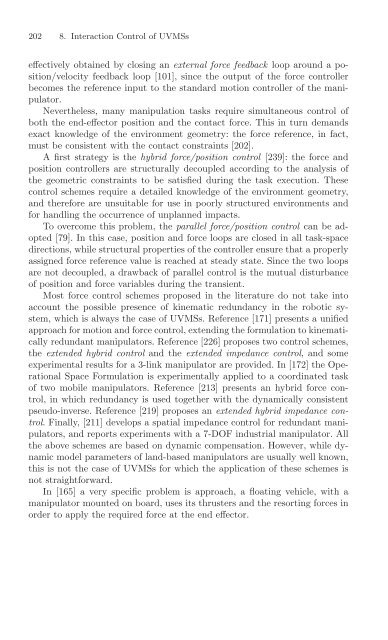Underwater Robots - Gianluca Antonelli.pdf
Underwater Robots - Gianluca Antonelli.pdf
Underwater Robots - Gianluca Antonelli.pdf
You also want an ePaper? Increase the reach of your titles
YUMPU automatically turns print PDFs into web optimized ePapers that Google loves.
202 8. Interaction Control of UVMSs<br />
effectively obtained by closing an external force feedback loop around aposition/velocity<br />
feedback loop [101], since the output of the force controller<br />
becomes the reference input to the standard motion controller of the manipulator.<br />
Nevertheless, many manipulation tasks require simultaneous control of<br />
both the end-effector position and the contact force. This in turn demands<br />
exact knowledge of the environment geometry: the force reference, in fact,<br />
must be consistent with the contact constraints [202].<br />
Afirst strategy is the hybrid force/position control [239]: the force and<br />
position controllers are structurally decoupled according to the analysis of<br />
the geometric constraints to be satisfied during the task execution. These<br />
control schemes require adetailed knowledge of the environment geometry,<br />
and therefore are unsuitable for use in poorly structured environments and<br />
for handling the occurrence of unplanned impacts.<br />
To overcome this problem, the parallel force/position control can be adopted<br />
[79]. In this case, position and force loops are closed in all task-space<br />
directions, while structural properties of the controller ensure that aproperly<br />
assigned force reference value isreached at steady state. Since the two loops<br />
are not decoupled, adrawback of parallel control isthe mutual disturbance<br />
of position and force variables during the transient.<br />
Most force control schemes proposed in the literature donot take into<br />
account the possible presence of kinematic redundancy in the robotic system,<br />
which isalways the case of UVMSs. Reference [171] presents aunified<br />
approachfor motion andforce control, extending the formulation to kinematically<br />
redundant manipulators. Reference [226] proposes two control schemes,<br />
the extended hybrid control and the extended impedance control, and some<br />
experimental results for a3-link manipulator are provided. In [172] the Operational<br />
Space Formulation is experimentally applied to acoordinated task<br />
of two mobile manipulators. Reference [213] presents an hybrid force control,<br />
in which redundancy isused together with the dynamically consistent<br />
pseudo-inverse. Reference [219] proposes an extended hybrid impedance control.<br />
Finally, [211] develops aspatial impedance control for redundant manipulators,<br />
and reports experiments with a7-DOF industrial manipulator. All<br />
the above schemes are based on dynamic compensation. However, while dynamic<br />
model parameters of land-based manipulators are usually well known,<br />
this is not the case of UVMSs for which the application of these schemes is<br />
not straightforward.<br />
In [165] avery specific problem is approach, afloating vehicle, with a<br />
manipulator mounted on board, uses its thrusters and the resorting forces in<br />
order to apply the required force at the end effector.






